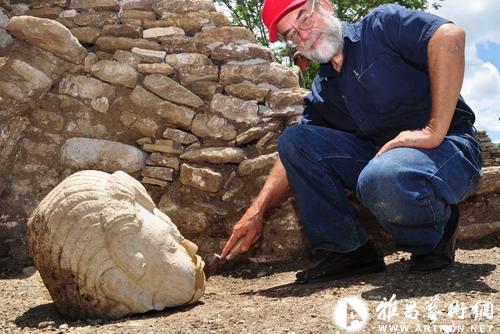编制机构:雅昌艺术市场监测中心(AMMA)

Dr. Juan Yadeun, responsible of the Archaeological Project at Tonina. The discovery confirms the alliance between Lordships of Copan, in Honduras, and Palenque, in Mexico at the war that Palenque fought against Tonina for 26 years (688 to 714 AD) to control the Usumacinta River. Photo: DMC INAH H. Montaño.
OCOSINGO, MEXICO.- Two Prehispanic sculptures made out of limestone that represent war captives and a pair of tableaux that marked the Ballgame, were found by Mexican specialists from the National Institute of Anthropology and History (INAH) at Tonina Archaeological Zone, in Ocosingo Municipality, Chiapas.
The discovery confirms the alliance between Lordships of Copan, in Honduras, and Palenque, in Mexico at the war that Palenque fought against Tonina for 26 years (688 to 714 AD) to control the Usumacinta River.
Sculptures of the prisoners of Copan and both tableaux, of an approximate age of 1300 years, were found buried in late May 2011, to the south of the Ballgame Court. “All the pieces were found broken: the tableaux in more than 30 fragments, one sculpture in 20 pieces and the other was found complete but presents 3 fractures”, informed Dr. Juan Yadeun, responsible of the Archaeological Project at Tonina.
Findings offer information about battles fought by Tonina 1000 years ago, unlike elements found in the same site in the 1990’s, which due to the bad conservation conditions they presented, could not help to understand Maya Civilization.
“The Sculptures –which are 1.5 meters high- are representations of Maya warriors made prisoners by ancient inhabitants of Popo (today Tonina), placed in the 4 corners of the court while still alive. After that, their depiction was placed there permanently to remind that the ruler had won the war against Maya cities of Palenque and Copan, as revealed by inscriptions found during excavations of the Ballgame Court”, mentioned archaeologist Yadeun.
The INAH specialist declared that “both sculptures have hieroglyphic inscriptions on the chest and loincloth that inform that these men were subjects of lord K’uy Nic Ajaw, from the lordship of Copan, today Honduras, during the age when Uaxaclajuun Ub’aah K’awiil, or 18 Rabbit, in the Epi Classic period (680-800 of the Common Era).
The discovery of 2 captives of Copan is physical evidence that confirms the alliance that Copan had with Palenque to fight Tonina, struggle that went over for more than 2 decades.
“Inscriptions also mention that captives were offered with fire and copal smoke during a ceremony related to the Ballgame Court; we think it might have occurred during the inauguration of the second decorative stage of the court at the Maya reign of Popo, near 695 AD, explained Dr. Yadeun.
On this regard, he added that Mayas from ancient Mexico believed that temples had their own life and they were born when inaugurated; possibly prisoners from Copan were part of the ritual.
The INAH archaeologist declared that the warrior sculpture found almost complete represents a semi naked man with cloth stripes hanging from his ears; this element is found in prisoners’ representations, which were stripped off their ear ornaments.
“Between Mayas, hair was tied before decapitation; both prisoners appear seated with their crossed legs and the hands tied on the back”, he explained.
Dr. Yadeun remarks that from 688 to 714 AD different battles between Tonina and Palenque took place, in order to control water of the region. Near 688 Yuhkno´m Wahywal, lord of Tonina, was captured and probably murdered by the firstborn son of Kinich Janaahb’ Pakal, ruler of Palenque, as inscriptions in Palenque point out. “This catastrophe must have changed ideology and world vision of inhabitants of Tonina.
“For this reason they destroyed iconography of several temples and the ballgame court; they destroyed the 6 markers with the form of the celestial serpents’ head, dated from the first constructive stage of the site and linked to the stars’ movement, the cosmos, cult to mountains and struggle between the lords of light (or heaven) and the lords of darkness (or the underworld, Xibalba), to constantly create and destroy the universe,” declared Yadeun.
“In 688 AD, K’inich Baak Nal Chaahk, lord of Popo, defeated Palenque and took several prisoners. Between 695 and 714 AD took place the second constructive stage at the court, which was dedicated to the victories of Tonina over their enemies, and where wars between the light and the darkness were represented.
“It was during this second stage that new markers were created, corresponding to the tableaux found recently, which inscriptions mention the dynastic title of the lord of Copan, K’uy Nik Ajaw” declared the INAH researcher.
Both tableaux were found in fragments and incomplete, and it can be observed the representation of a serpent carved around, as well as the image of a sacrificed captive in the center of each of them, concluded the archaeologist.
责任编辑:罗书银
推荐关键字:Archaeologists Maya Civilization Sculptures
注:本站上发表的所有内容,均为原作者的观点,不代表雅昌艺术网的立场,也不代表雅昌艺术网的价值判断。

网友评论仅供其表达个人看法,并不表明本站同意其观点或证实其描述。